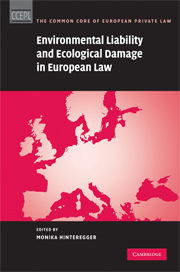Book contents
- Frontmatter
- Contents
- Preface
- Acknowledgments
- General editors' preface
- Notes on the contributors
- Table of treaties
- Table of legislation
- List of abbreviations
- Part I Environmental liability in Europe
- 1 International and supranational systems of environmental liability in Europe
- 2 Some observations on the law applicable to transfrontier environmental damage
- Part II The case studies
- Part A Scope of liable persons
- Part B Causation and multiple tortfeasors
- Part C Remedies and legal standing
- Case 15 Contaminated land
- Case 16 The polluted river
- Case 17 The oil spill
- Case 18 Contaminated drinking water
- Part III Comparison, summary and conclusions
- Bibliography
- Index
Case 15 - Contaminated land
from Part C - Remedies and legal standing
Published online by Cambridge University Press: 23 July 2009
- Frontmatter
- Contents
- Preface
- Acknowledgments
- General editors' preface
- Notes on the contributors
- Table of treaties
- Table of legislation
- List of abbreviations
- Part I Environmental liability in Europe
- 1 International and supranational systems of environmental liability in Europe
- 2 Some observations on the law applicable to transfrontier environmental damage
- Part II The case studies
- Part A Scope of liable persons
- Part B Causation and multiple tortfeasors
- Part C Remedies and legal standing
- Case 15 Contaminated land
- Case 16 The polluted river
- Case 17 The oil spill
- Case 18 Contaminated drinking water
- Part III Comparison, summary and conclusions
- Bibliography
- Index
Summary
A is the operator of a facility that is used for the proper treatment of hazardous chemicals. An explosion occurs and large amounts of chemicals contaminate the soil of the surrounding land.
Who has standing to bring legal action as a result of the damage? What is the remedy?
Plaintiff B is one of the owners of the contaminated land. To what type of claim is B entitled, if the land can be restored to its original condition?
Immediately after the incident, public authorities took costly emergency measures in order to prevent further damage. Does A have to pay these costs? What happens if these emergency measures cause property damage to C? Does A have to pay these costs, too?
The neighbour C has not been directly affected by the disaster. He/she, however, finds that the market value of his/her land has dropped because of the incident. The property is now unsaleable, or at least seriously devalued, by the proximity to the contaminated site. Does C have a right to sue A for damages?
Would it make any difference if it could be shown that A was negligent?
Comparative remarks
Comparison
Legal standing
Contamination of land usually qualifies as property damage. In all European states, if such damage occurs, the owner of the land is entitled to claim damages according to tort law.
- Type
- Chapter
- Information
- Environmental Liability and Ecological Damage In European Law , pp. 435 - 477Publisher: Cambridge University PressPrint publication year: 2008

